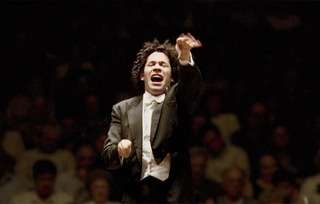|
Back
Living Up To The Hype Amsterdam
Concertgebouw Grote Zaal
05/22/2009 -
Carlos Chávez: Symphony No. 2, “Sinfonia India”
Edvard Grieg: Piano Concerto in A Minor, Op. 16
Sergei Prokofiev: Symphony No. 5 in B-flat Major, Op. 100
Jean-Yves Thibaudet (piano)
Royal Concertgebouw Orchestra, Gustavo Dudamel (conductor)

G. Dudamel (© Dan Porges)
Ah, to be 28 again! With all the virility and vigor of a newly-awakened adolescent, the audacious Wunderkind Gustavo Dudamel brought the house down at the Concertgebouw, coaxing exaggerated, dramatic performances from one of the most storied orchestras in the world. This was my first encounter with the conductor live and, like the rest of the audience, my expectations were extremely high. All involved exceeded them in every way.
The concert kicked off with the Sinfonia India by Carlos Chávez, a neglected masterpiece. As Leonard Bernstein said, the generative elements of the work are “choppy, unemotional, almost wooden-like, Indian, in other words, primitive. But primitive music can be very thrilling, even if it's also quite limited.” Dudamel worked brilliantly with the economic score. Conducting from memory, his motions were balletic and he created a finely sculpted traversal of the work’s four sections. The energy of the opening was arresting and the lyrical central theme impassioned and extravagantly but tastefully hyperbolic in its ebbs and flows. The orchestra played with aplomb, with the two piccolos and E-flat clarinet shrieking gleefully above the texture, the strings glorious in the aforementioned lyrical section, and the percussion clearly enjoying the exotic spices they were dishing up from each respective mise en place. One hopes that Dudamel’s championing of this work will increase its hold on the repertoire.
The aristocratic Jean-Yves Thibaudet was on hand for the Grieg concerto. Not to be outdone by Dudamel, Thibaudet was flamboyant and maximized the contrasting moods in the piece. He drew an enormous range of colors from the piano, matching the variety in Grieg’s orchestration with imaginative pedaling and risky dynamic choices, especially on the soft end. In the first movement, the second theme was especially well-rendered. As if to provide maximum contrast with his maniacal, technically stunning cadenza, Thibaudet withdrew to an almost inaudible pianissimo, with almost overdone rubato that returned to rhythmic integrity at just the right moments. This style of playing returned in the opening of the second movement, and both conductor and pianist turned boldly aggressive in the middle section. Fine horn contributions added warmth to the outer sections. The rather brisk pace of the finale, more Allegro, less molto moderato, again set up the potential for a divergent lyrical theme, yet here Thibaudet produced a gorgeous, dark tone that was full and showed yet another dimension of his artistry. He and Dudamel worked together impeccably. This was a refreshing, rollercoaster ride of a performance of a work that can often sound overly sentimental.
If the Prokofiev symphony given after intermission seemed a slight disappointment, it might be because the amount of interpretive ingenuity given by the performers on the first half left the audience spent. This is not to denigrate the performance in any way. The orchestra was superb, the brass pungently accurate, the E-flat clarinet again adding zealous piquancy to the texture, the strings relishing their open-string pizzicato and soaring lyrical lines. The opening Andante, with its elaborately woven counterpoint, was a study in architecture, every phrase leading inevitably forward. The coda was truly earth-shattering, with enormous tam-tam and low brass contributions that shook the rafters. Dudamel’s interpretation of the scherzo will likely receive much commentary worldwide, especially the da capo. Dudamel starts extremely slowly, grotesquely sculpting the woodwinds’ flailing gestures and encouraging the brass to produce nasty rasps. He then continues a magnificently controlled accelerando and crescendo clear through the recapitulation to the end of the movement, perfectly timed so that the movement ends right at the threshold, when the tempo and dynamic increases, if taken any further, would cause everything to collapse into chaos. The problematic Adagio could have perhaps benefited from a more cool-headed approach, yet the control from the podium was admirable, and the playing of this very difficult movement was extraordinary. The finale showed Dudamel trading in intensity for the appropriate giocoso feeling. Led by his playful gestures, the orchestra basked in the movement’s energy and optimism. The abrupt ending of the work never gets quite the audience reaction that the piece deserves, yet after a short hesitation the sold-out crowd was on its feet, lauding the orchestra and the Venezuelan maestro with no fewer than five curtain calls.
Needless to say, Dudamel is the real deal. Hopefully his interpretive gambles and unflagging charisma inspire the new generation of performers and audiences and reinvigorate the old guard.
Marcus K. Maroney
|